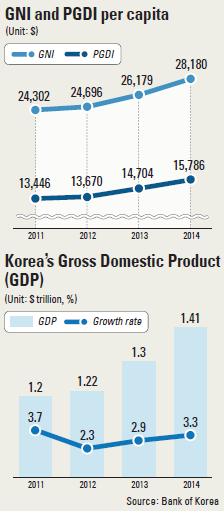Korea’s per capita GNI rose to $28,000 last year

Official data by the Bank of Korea showed Wednesday that Asia’s fourth-largest economy recorded 1,332 trillion won ($1.2 trillion) in gross domestic product in 2014. Its per capita gross national income (GNI) stood at $28,180 in 2014, a 3.8 percent increase from $26,179 a year earlier.
The GDP growth rate, 3.3 percent, was the same as an initial estimate announced by the central bank in January. On a quarterly basis, the growth pace of GDP was slower in the second half of 2014, retreating from 1.1 percent in the first quarter to 0.3 percent in the fourth.
The increase in per capita GNI, 3.8 percent, was mainly thanks to a weak dollar in 2014, which fell 3.8 percent against the won, a BOK official said.
“The main reason for the increase in the GNI figure is because of the improved trading conditions with a weak dollar against the won,” said a BOK official by phone.
The increase in GNI doesn’t translate into improvements for each household in Korea, economists say, because the figure includes the incomes of companies and the government.
Economists say the Personal Gross Disposable Income (PGDI) is a better index of household incomes. The PGDI was $15,786 per head in 2014, 3.9 percent larger than the year before.
“As we can’t tell the effective household income through per capita GNI, we also released the PGDI figure,” Lee Gwan-gyo, a BOK official said by phone. “But considering that it also includes incomes from NGOs and religious groups, the actual income of each Korean is smaller than that figure.”
The ratio of PGDI to GNI per capita has been about 55 percent for the past few years and was 56 percent in 2014, much lower than the Organization for Economic Cooperation and Development average of 62.6 percent in 2012, according to BOK.
“The low ratio of PGDI to GNI means manufacturers and producers make lots of profits through overseas production, but those profits did not trickle down to consumers in the country,” said Yoo Geyong-joon, a chief economist at the Korea Development Institute.
Although their incomes grew last year, Koreans saved more and inflation slowed, the BOK report also reported.
The GDP price deflator, a price index representing comprehensive price changes based on GDP, recorded a 0.6 percent growth rate, retreating from 0.9 percent in 2013.
It was the second-lowest growth since Statistics Korea started to estimate the figure in the current form in 2000. The lowest was in 2006, when Korea recorded minus 0.1 percent.
The savings rate of households in Korea also rose to 6.1 percent from 4.9 percent a year earlier, the report said. The PGDI recorded a 3.9 percent increase but total expenses of households only rose 3.3 percent, the report said.
“The increase in savings appears to be due to the aging society,” said Yoo, the KDI economist. “While the society is rapidly aging, people feel the social welfare system is lacking so they feel compelled to save. This also indicates why Korea’s domestic market is sagging.”
BY KIM HEE-JIN [kim.heejin@joongang.co.kr]










with the Korea JoongAng Daily
To write comments, please log in to one of the accounts.
Standards Board Policy (0/250자)